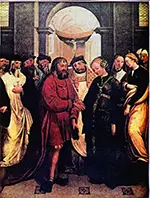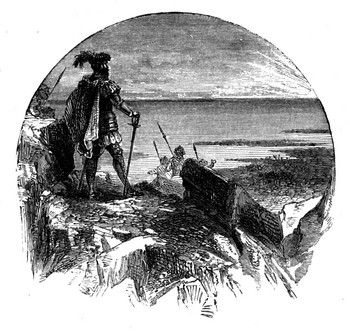King Manuel I of Portugal
Manuel I was King of Portugal for 26 years, at the end of the 15th Century and into the early 16th Century. A rich and famous monarch, he presided over the further ascension of his country as a great power. 
He was born on May 31, 1469, in Alcochete, Portugal. He had extensive ties to the royal family. His father, Ferdinand, Duke of Viseu, was the son of King Edward and the brother of King Afonso V. His mother was Beatriz of Portugal, whose grandfather was King John I. In addition, Manuel's sister Leonor was the wife of King John II. King John II adopted Manuel when the boy was 15. The king and Queen Leonor had had a son, Afonso, whom they hoped would be the next king. The boy died in a horse riding accident in 1491. John had another son, Jorge, whose mother was not Leonor, and John wanted to name this other son as his successor. He found no support for the move, however, and, in 1493, named to succeed him Manuel. The king died on Oct. 25, 1495, and Manuel became king. 
In 1497, Manuel married Isabel, the widow of John II's son Afonso and, as the daughter of Ferdinand and Isabella, a crown princess of Aragon and Castile. She died giving birth to their son, Miguel, in 1498. The young boy was heir to three thrones—Aragon, Castile, and Portugal—but died in 1500. King Manuel then married his wife's younger sister, Maria (right). They had 10 children, eight of whom lived into adulthood: John (1502), Isabel (1503), Beatriz (1504), Luís (1506), Fernando (1507), Afonso (1509), Henry (1512), and Duarte (1515). 
Manuel encouraged his country's expanding explorations of the world. He approved the voyage of Vasco Da Gama to India and followup the voyage of Perdo Álvares Cabral, which in 1500 found Brazil before reaching India. The voyages from Portugal to India proliferated, exceeding 250 during Manuel's time on the throne. Portuguese traders brought back large amounts of spices, enriching the royal coffers to the extent that for a time, Manuel was the richest ruler in Europe. To administer Portuguese interests there, Manuel in 1505 appointed Francisco de Almeida as the first of many to hold the title of Viceroy of India. Manuel's reach extended further east, as he concluded a commercial treaty with Ming Dynasty China and in 1511 captured Malacca in what is now Malaysia. 
This king introduced measure of judicial reform and used much of his wealth to sponsor construction of new buildings (in what came to be called the Manueline style). Among the new construction were a number of monasteries and other religious buildings. One of the most striking was the Tower of Belém. The devout Manuel had, as a condition of marrying Isabella, daughter of the Catholic Monarchs who expelled the Jews from Spain in 1492, agreed to do the same thing in Portugal. Manuel issued a conversion edict in December 1496. All Jews living in Portugal had until October 1497 to convert to Christianity or leave the country. Those who stayed, agreeing to forced baptism, came to be called New Christians, and the king gave a grace period of 30 years. One glaring exception to this was the Lisbon massacre, the killing of thousands of suspected Jews by a mob in April 1506. The king responded harshly, executing the mob leaders. Manuel continued to be a popular, rich, and well-known monarch and was known as Manuel the Fortunate. Queen Maria died in 1517, and Manuel married a third time, to Eleanor of Austria, in 1518. One of King Manuel's last acts had been to deny sponsorship of a sailor from his own ranks, Ferdinand Magellan, who stood falsely accused of theft. Magellan then took his ideas of circumnavigating the globe to the Spanish court, which proved receptive. Magellan's voyage succeeded the following year, when his remaining ship returned to the Spanish court of Charles I. Yet another outbreak of the Black Death in 1521 forced the king and his court to stay inside the royal palace. Manuel contracted a severe illness that killed him on Dec. 13, 1521. Succeeding him as king was his oldest son, who became King John III. |
|
Social Studies for Kids
copyright 2002–2024
David White




